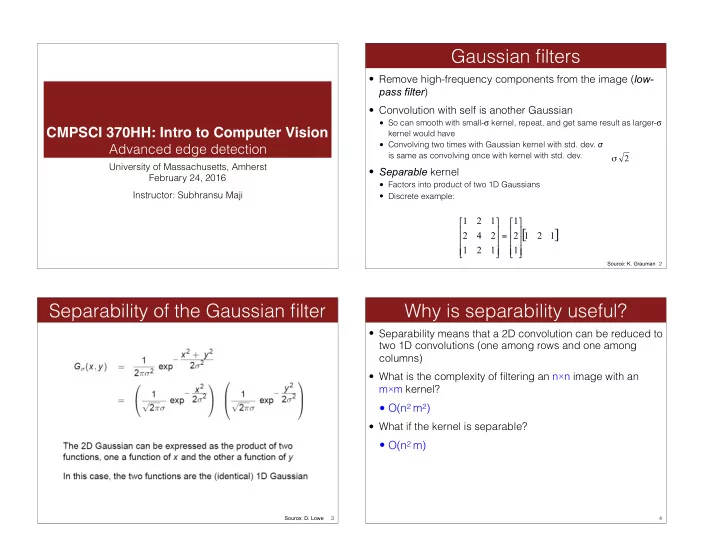

Gaussian filters • Remove high-frequency components from the image ( low- pass filter ) • Convolution with self is another Gaussian • So can smooth with small- σ kernel, repeat, and get same result as larger- σ CMPSCI 370HH: Intro to Computer Vision kernel would have • Convolving two times with Gaussian kernel with std. dev. σ Advanced edge detection is same as convolving once with kernel with std. dev. 2 σ University of Massachusetts, Amherst • Separable kernel February 24, 2016 • Factors into product of two 1D Gaussians Instructor: Subhransu Maji • Discrete example: 1 2 1 1 & # & # $ ! $ ! 2 4 2 2 [ 1 2 1 ] = $ ! $ ! 1 2 1 1 $ ! $ ! % " % " Source: K. Grauman 2 Separability of the Gaussian filter Why is separability useful? • Separability means that a 2D convolution can be reduced to two 1D convolutions (one among rows and one among columns) • What is the complexity of filtering an n × n image with an m × m kernel? • O(n 2 m 2 ) • What if the kernel is separable? • O(n 2 m) Source: D. Lowe 3 4
The Canny edge detector The Canny edge detector 1. Filter image with derivative of Gaussian original image 2. Find magnitude and orientation of gradient 3. Non-maximum suppression : • Thin wide “ridges” down to single pixel width 4. Linking and thresholding ( hysteresis ): • Define two thresholds: low and high • Use the high threshold to start edge curves and the low threshold to continue them MATLAB: edge(image, ‘canny’); J. Canny, A Computational Approach To Edge Detection , IEEE Trans. Pattern Analysis and Machine Intelligence, 8:679-714, 1986. Slide credit: Steve Seitz 5 6 The Canny edge detector The Canny edge detector norm of the gradient thresholding 7 8
The Canny edge detector Non-maximum suppression How to turn these thick regions of the gradient into curves? Check if pixel is local maximum along gradient direction, select single max across width of the edge • requires checking interpolated pixels p and r thresholding 9 10 The Canny edge detector Hysteresis thresholding Use a high threshold to start edge curves, and a low threshold to continue them. Problem: pixels along this edge didn’t survive the thresholding thinning (non-maximum suppression) Source: Steve Seitz 11 12
Hysteresis thresholding Recap: Canny edge detector 1. Compute x and y gradient images 2. Find magnitude and orientation of gradient 3. Non-maximum suppression : • Thin wide “ridges” down to single pixel width 4. Linking and thresholding ( hysteresis ): • Define two thresholds: low and high original image • Use the high threshold to start edge curves and the low threshold to continue them MATLAB: edge(image, ‘canny’); high threshold low threshold hysteresis threshold J. Canny, A Computational Approach To Edge Detection , IEEE Trans. (strong edges) (weak edges) Pattern Analysis and Machine Intelligence, 8:679-714, 1986. Source: L. Fei-Fei 13 14 Modern edge detection Modern techniques • "Learning to Detect Natural Image Boundaries Using Brightness and Texture" D. Martin, C. Fowlkes, and J. Malik. NIPS 2002 • Boundary prediction as a machine learning problem • Lot of early work from the Berkeley vision group 15 16 http://www.eecs.berkeley.edu/Research/Projects/CS/vision/grouping/papers/mfm-pami-boundary.pdf
A very fast version Further thoughts and readings … • Random forest edge detector (Piotr Dollar et al., ICCV 13) • Hybrid images project • http://cvcl.mit.edu/hybridimage.htm • Canny edge detector • www.limsi.fr/Individu/vezien/PAPIERS_ACS/canny1986.pdf • Bilateral filtering for image denoising (and other application) • http://people.csail.mit.edu/sparis/bf_course/ • If all else fails www.xkcd.com 17 18
Recommend
More recommend